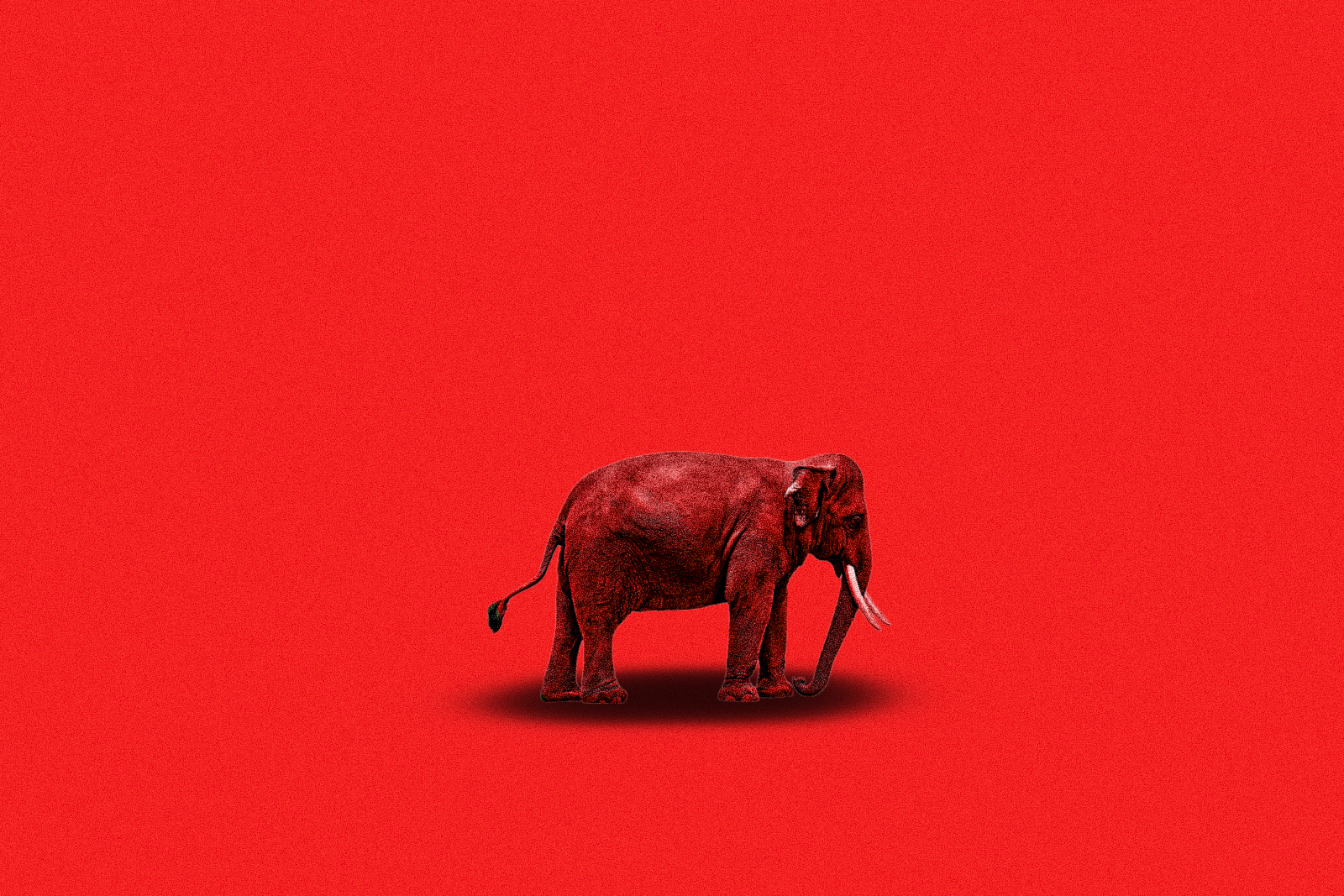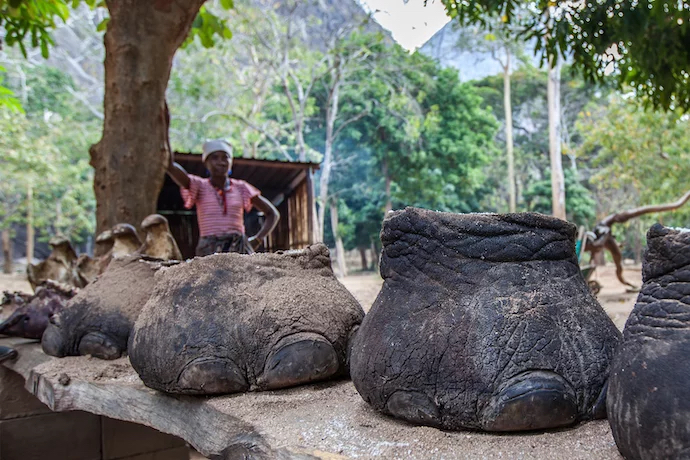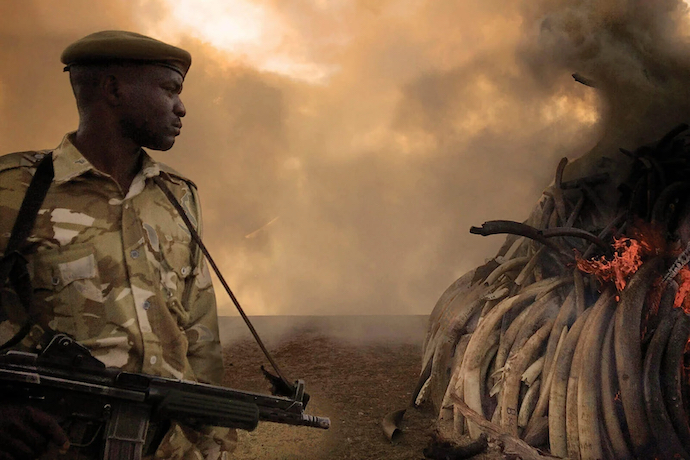
Kenya Still Struggling with Consistency and Deterrence in Ivory Cases
It would have been a safe bet to wager. On January 18, 2014, in Nampula, Mozambique, Tang Tongjian, a 40-year-old Chinese national, boarded a flight to China, transiting Nairobi, Kenya. His luggage contained a 3.4 kg piece of ivory. Would he have had even the slightest inkling that he was just days away from becoming a poster boy for Kenya’s freshly reinvigorated Wildlife Conservation and Management Act (WCMA)? Mere hours after departure, Tongjian was under arrest at Nairobi’s airport, and the ivory was in the hands of the police.
Ten days later, Tongjian pled guilty in a Nairobi courtroom and was ordered to pay a $200,000 fine or serve seven years in prison. The guilty plea heralded the re-introduction of Kenya’s wildlife legislation, now with stringent, no-nonsense penalties. Tongjian was its first conviction.
The sentence was seen as a game changer meant to stem ivory poaching. Paul Udoto, the former spokesperson for the Kenya Wildlife Service, referred to it as a “landmark ruling,” one that will make the “killing of wildlife a high-cost business.” “It’s very motivating for our rangers” to see poachers “lose a lot of money and spend long terms in Kenyan prisons.”
Fast forward several years, in a Nairobi courtroom, the story and dialogue have changed. On December 15th, 2022, Thomas Muhoro Ngatia was sentenced to two years in prison without a fine after being found guilty on two counts relating to the possession and trafficking of 112 kg of ivory in 2016. The sentences were to run concurrently. While members of the media were present, it did not make the news. There was no statement from the Kenya Wildlife Service.
Ngatia was not a foreign national passing through Kenya with just a single ivory tusk. He was not the average level one poacher, killing elephants for survival. He was a key player in a criminal network that collected and trafficked ivory to buyers in Asia. While out on bail for the first offence, Ngatia was arrested a second time with 55 kg of ivory for which he made bail.
It began with Ngatia’s initial arrest in 2016, at his family’s home on the outskirts of Nairobi. During their search, the police found 40 pieces of ivory under his bed. Such was the importance of the arrest that the seizure site was attended by Francis Muhoro Ndegwa, the former head of the Directorate of Criminal Investigations (DCI). In the press conference that followed, Ndegwa stated that the home was being used as a temporary storage site. “We have found materials in his house that suggest he is part of a transnational gang that is dealing in ivory.”

Ngatia’s confession to the police backs up Ndegwa’s comments. Ngatia told investigators that he had been in the ivory business since 2008, having been recruited by Fredrick James Muchina, a local businessman. Muchina paid him $10 per kilogram of ivory sold.
Muchina was a name not unfamiliar to the public. In an investigative documentary, Muchina was named as a lead figure in the poaching and trafficking of ivory and rhino horn throughout Kenya. He had links to Guinean traffickers in West Africa. Muchina was also named as being specifically involved with rogue elements of the Kenya Wildlife Service in the staged killing of two “alleged” poachers outside the perimeter wire of Solio Ranch, a rhino conservancy.
Whether or not Muchina was ever going to be charged became mute when an unknown gunman fired six shots into his chest. It was a targeted assassination by either corrupt police officers to silence him or government agents tired of his evading justice. Suffice it to say, Ngatia was not the average poacher.
Ngatia had top-notch legal representation throughout his trial. A defence team that successfully saw him released on bail and the recall of two prosecution witnesses led to the proceedings moving to the courtroom of Judge E. Riany over alleged bias. It was clear that for a man who declared himself a “hardware merchandise supplier,” his defence was being bankrolled from another source.
It was somewhat of a surprise when on November 24, 2022, Riany found Ngatia guilty on both counts. Hopes that Ngatia’s conviction signaled the unshackling of cartel influence were dashed when the two-year prison sentence was hurriedly read in court on a Thursday afternoon, three weeks later.
What happened to the justice that was promised with Kenya’s Wildlife Conservation and Management Act? What happened to the promise of heavy fines in the hundreds of thousands of dollars and long prison sentences? Ngatia was sentenced to two years in prison for ivory trafficking, who, while out on bail for the first offence, was arrested for a second ivory trafficking offence and made bail again. To add insult to injury, Ngatia’s pre-sentence report did not portray him as a remorseful, responsible, and upstanding citizen. Should there be a surprise that on the departure of Riany from the courtroom after the sentencing, Ngatia was overheard saying: “My brothers had already sorted it out.”
Ngatia’s sentence was not appealed perhaps for obvious reasons.
One week after Ngatia’s sentencing, another troubling decision was being made in a Mombasa courtroom. While the WCMA was not under the spotlight for this prosecution, the principles of sentencing in Kenyan wildlife cases were.
On December 22, 2022, James Ngala Kassiwa, a Kenya Revenue Authority (KRA) officer, had an ivory-related two-year prison sentence reduced to non-custodial probation after serving only nine months. Kassiwa had been convicted for his role in a 3.8-tonne ivory seizure at the Port of Mombasa in 2013.
Kassiwa had applied to the courts for a sentence review based on the trial judge having erred on several issues relating to his sentencing, including being a first-time offender, an officer for 20 years, and other mitigating factors relating to his age, health, and family status. Judge A. Ong’injo accepted the recommendations of a sentence review report and released Kassiwa three days before Christmas.

Once again, when this prosecution and the related investigations are examined, one must question if there were no other forces in play besides the rule of law. The term ‘related investigations’ is used here as Kassiwa was not originally charged for involvement in just one ivory shipment, but for three.
For clarity, the specific prosecution for which Kassiwa was granted probation stems from the seizure of 3.8 tonnes of ivory made at the Port of Mombasa in January 2013. He was also charged in relation to a 1.3-tonne ivory seizure made in Hong Kong that same month and a 1.8-tonne seizure made in Singapore, also around the same time.
But the picture is bigger. In internal correspondence from police investigators in Mombasa dated two months after the 3.8-tonne seizure, it was stated: “We did expand the scope of our inquiries and have established that the same forwarder has successfully shipped and delivered a total of thirty-three (33) containers to various consignees in Vietnam, Thailand, Singapore, and China between 2011 and 2012.”
The letter also read: “Shipment(s) were exported using fake customs entries and bypassed the established protocols. It is our considered opinion that all these containers contained prohibited cargo mostly Ivory…smuggled into the Port through irregular loading into vessels in cooperation with employees of the Kenya Revenue Authority and the Kenya Ports Authority.”
Subsequent DNA analysis confirmed the transnational criminal element. The ivory in the Mombasa 3.8-tonne shipment was directly linked to a 1.5-tonne ivory shipment seized in Dubai four months later. This Dubai shipment was linked directly through DNA analysis to a 2.9-tonne seizure made in Mombasa in October 2013 that was in turn directly linked to a 6-tonne seizure made in Malaysia in December 2012 and a 1.8-tonne seizure made in Uganda in May 2014. This all points to one supplier being behind all these shipments later found to be the West African Cartel.
A Kenyan joint task force set up to investigate the three shipments initially charged James Ngala Kassiwa, as well as Gideon Naftali Osinyo, a Kenya Ports Authority (KPA) officer. Two weeks later, clearing agent Fredrick Sababu Mungule was also charged. These charges were in relation to the Mombasa and Hong Kong shipments and under the East African Community Customs Management Act. Each defendant faced five-year sentences for each of the charges.
Seven months later, these men were charged for the Singapore seizure and under a separate file. This was a curious decision. Separating the court files meant that there were going to be two distinct trials essentially involving all the same witnesses but in different courts with different judges and prosecutors. It would seriously weaken and compromise the prosecution.
No other charges were ever laid in relation to the 31 other containers as identified in the internal official police correspondence.
Predictably, the second prosecution for the Singapore seizure failed. The case had been clearly compromised and included unchallenged hostile testimony from the lead investigator and death threats to the staff of Wildlife Direct, a Kenyan NGO, which was monitoring the case at the time.
Judge Francis Kyambia ruled on February 11, 2022, that the prosecution had not established a prima facie case. James Ngala Kassiwa, Fredrick Sababu Mungule, and Nelson Ayoo (another KRA officer) walked free. Gideon Naftali Osinyo had at this point died, reportedly from illness.
Just over one month later, however, the tide of acquittals surprisingly turned. On March 23, 2022, Judge E. Nyaloti found both guilty and sentenced each to two years in prison. This was in relation to the Mombasa seizure. The two charges relating to the Hong Kong seizure had disappeared under the guise of what was referred to as case consolidation. The court never heard any direct evidence relating to that shipment.
This conviction was bittersweet. While celebrated as the first conviction in a major ivory case in Kenya since at least 2009 (ivory trafficker Feisal Mohamed Ali had been convicted in 2016 but it was overturned on appeal), the sentence of two years in prison was seen as insipid considering the amount of ivory involved and the trans-national organized crime element.
There is no doubt that Kassiwa was the scapegoat for corrupt officers who were equally responsible for smuggling ivory out of Kenya through its ports. But what message were the courts sending when a person who assists a trans-national criminal cartel in trafficking receives non-custodial probation seven months into an already token two-year prison term? And was any consideration given as to how Kassiwa, apparently fired from KRA immediately on arrest, was able to afford arguably the top defence lawyer in Mombasa, Jared Magolo, for the over 100 court sittings required in the two separate trials?
‘Anything goes’ or haphazard?
A recent study said the following about the WCMA: “But ambiguities remain, especially regarding sentencing. The variations in sentencing reported here reflect a lack of oversight over judicial approaches to sentencing that cut across the entire range of criminal offences…this situation where ‘anything goes’ limits the effectiveness of the law.” Perhaps ‘haphazard’ would be a more accurate term.
In July 2018, Paul Njogu Muthoni and Isaac Mbugua Mburu, charged under similar circumstances to Ngatia (also connected to the West African cartel), were found guilty of being in possession of 155 kg of ivory. They were sentenced to eight years in prison. They appealed their sentence separately to two different courts and both appeals were dismissed in 2020.
In January 2022, a court in Voi, near the Tsavo National Park, reduced a 10-year prison sentence to seven years of non-custodial probation for dealing 38 kg of ivory. In October 2022, a Rift Valley court in Kitale convicted Martin Mukesa Juma of possession of 4 kg of ivory and sentenced him to a $10,000 fine or in default, one year in prison.
No examples of sentencing in major wildlife prosecutions can be provided as there have been no other convictions.
The renewed and purportedly revigorated Wildlife Crime and Management Act, promulgated through the 2014 conviction of Tongjian, the Chinese national, lasted but 48 hours before the virus activated. On January 30, Zhang Chen Sheng, another Chinese national also in transit to China, pled guilty to a similar offence while in possession of 300 grams of worked ivory in the form of bangles and other jewelry.
The sentence of a $10,000 fine or in default 5 years in prison was appealed as being too lenient. The ploy backfired. Just weeks later, a Nairobi court ruled that the new section of the WMCA that provided teeth was “ambiguous” and acquitted Sheng. It is a decision that still haunts the Wildlife Conservation and Management Act.
And unsuspecting WMCA poster boy, Tang Tongjian? He appealed successfully and was released, time served, three years later.

